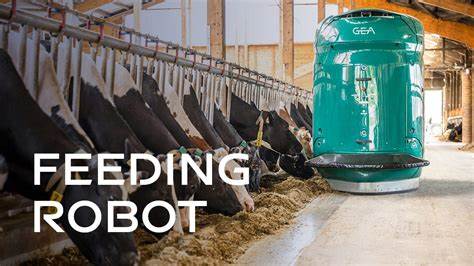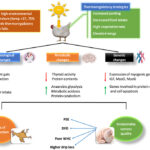
1. Introduction
Feeding systems in commercial dairy farms are structured approaches used to deliver balanced rations to dairy animals efficiently and consistently. The choice of feeding system significantly influences:
- Milk yield and composition
- Animal health and longevity
- Feed efficiency and farm profitability
With increasing herd sizes and market demand, modern dairy farms must adopt scientific and cost-effective feeding strategies that maximize productivity while minimizing waste and labor.
2. Goals of a Commercial Dairy Feeding System
- Provide a balanced and consistent diet meeting the animal’s nutrient requirements.
- Minimize feed wastage and sorting.
- Enhance rumen function and feed intake.
- Optimize milk production and reproduction.
- Facilitate labor efficiency and automation.
3. Major Types of Feeding Systems
A. Total Mixed Ration (TMR)
Definition:
A feeding system in which all dietary components—forages, concentrates, minerals, and additives—are mixed into a single uniform blend and fed free-choice.
Key Features:
- Ingredients include chopped hay/silage, grains, protein supplements, vitamins, and minerals.
- Mixers (horizontal or vertical) are used to prepare and distribute the ration.
Advantages:
- Ensures uniform nutrient intake.
- Reduces feed sorting and competition.
- Increases milk production and feed efficiency.
- Improves rumen health by stabilizing pH.
Challenges:
- High initial investment in mixing equipment.
- Requires accurate formulation and weighing.
- Needs skilled labor for ration preparation.
B. Component Feeding (Conventional Feeding)
Definition:
Animals are fed forages and concentrates separately and often at different times.
Feeding Regime:
- Forages offered free-choice or limited.
- Concentrates given individually or in groups, often during milking.
Advantages:
- Simple and requires less equipment.
- Useful in small-scale or transitional farms.
Challenges:
- Risk of unbalanced intake (over- or under-consumption of concentrate).
- Greater variation in nutrient intake among animals.
- Lower feed efficiency than TMR systems.
C. Partial Mixed Ration (PMR)
Definition:
Animals receive a mixed ration (forages + some concentrates) in the feeding area, and additional concentrate is given individually during milking.
Advantages:
- More control over concentrate intake.
- Allows customization for high-yielding cows.
- Combines TMR benefits with individual feeding flexibility.
Challenges:
- Requires extra labor to feed twice.
- Risk of imbalanced rations if not well-planned.
D. Grazing-Based Feeding System
Definition:
Cows graze on pasture-based systems, supplemented with concentrates or silage as needed.
Best for:
- Low-input or organic dairy farms.
- Regions with year-round grazing availability.
Advantages:
- Low-cost feeding option.
- Natural cow behavior and welfare.
- Less need for feed processing.
Challenges:
- Seasonal limitations.
- Lower and more variable milk yields.
- Land requirement and pasture management needed.
4. Key Components of a Commercial Dairy Feeding Program
A. Forages
- Provide fiber for rumen health.
- Examples: corn silage, alfalfa hay, Napier grass, sorghum.
- Target 40–60% of dry matter (DM) intake.
B. Concentrates
- Provide energy (grains) and protein (soybean/cottonseed meals).
- Formulated based on milk yield and body condition.
C. Mineral and Vitamin Supplements
- Macro minerals (Ca, P, Mg, Na, K)
- Trace minerals (Zn, Cu, Se, Mn)
- Vitamins A, D, E, B-complex
D. Feed Additives
- Yeast cultures, buffers (e.g., sodium bicarbonate), enzymes, ionophores.
- Improve digestion, reduce acidosis, and enhance performance.
5. Automation and Technology in Modern Feeding Systems
Automated Feed Mixers and Wagons
- Consistent mixing and delivery.
- Reduced labor cost.
Electronic Identification (RFID) and Smart Feeders
- Allow individualized feeding based on lactation stage or yield.
Feeding Software and Data Management
- Helps formulate and track diets.
- Integrates with milk production data for better decision-making.
6. Nutritional Considerations for Lactating Dairy Cows
| Nutrient | Requirement (Approximate) |
|---|---|
| Crude Protein (CP) | 16–18% (DM basis) |
| Total Digestible Nutrients (TDN) | 65–72% |
| Effective Fiber | 20–25% |
| Net Energy for Lactation (NEL) | 1.6–1.7 Mcal/kg (DM) |
| Calcium | 0.7–1.0% |
| Phosphorus | 0.4–0.6% |
| Water | 3–5 liters per liter of milk |
7. Feeding Strategies Based on Lactation Stage
| Stage | Feeding Focus |
|---|---|
| Fresh Cows (0–30 days) | High-energy, rumen-protected nutrients |
| Peak Lactation (30–100 days) | Maximize intake, support milk production |
| Mid Lactation | Balance intake with milk yield |
| Late Lactation | Restore body reserves |
| Dry Period (60 days before calving) | Low energy, high fiber, prepare for next lactation |
8. Challenges in Dairy Feeding Systems
- Feed cost and availability fluctuations
- Nutrient imbalances due to poor ration formulation
- Mycotoxins or spoilage in silage and stored feed
- Labor shortage or lack of training in feed management
- Sorting behavior in TMR-fed herds if poorly mixed
9. Conclusion
A well-designed feeding system is essential to the success of commercial dairy operations. Total Mixed Ration (TMR) is considered the gold standard in large-scale systems, but hybrid systems like PMR or pasture-based feeding with supplementation are effective depending on local resources and scale. The key is to ensure balanced nutrition, consistency, and monitoring, supported by trained staff and, where feasible, automation and technology.




23-CUVAS-0315
23-cuvas-0313
23-CUVAS-0329
Talha Zeeshan
0325
23-CUVAS-0329
Talha Zeeshan
23-CUVAS-0329
Talha Zeeshan
23-CUVAS-0312
DVM 4TH
23-cuvas-0336
23-CUVAS-0291
23-cuvas-0314
23-cuvas-0316 DVM 4th
Preetam Raam
23-CUVAS-0334
DVM 4th
23-cuvas-0322
23-cuvas-0314
Laiba Hafeez
Reg no : 23-cuvas-0298
DVM 4th semester
23-cuvas-0316
23-CUVAS-0329
Talha Zeeshan
Muhammad Ahmad 23-cuvas-0316. DVM 4th
23-CUVAS-0291
DVM 4th sems
23-cuvas-0308
23-CUVAS-0337
DVM (4th Semester)
Waseem saleem
…………………
23-cuvas-0617
23-CUVAS-0329
Noman toufiq
23_cuvas_0301
Dvm 4th
23-CUVAS-0290
Muhammad Bilal
23-CUVAS-0290
DVM 4th
23-cuvas-0321
Laiba Hafeez
Reg no : 23-cuvas-0298
23-cuvas-0300
23-CUVAS-0303
23-CUVAS-0291#
23-cuvas-0336
Abdullah Sharif 23-Cuvas-0332
23-CUVAS-9303
333
Very informative site
23-CUVAS-0315
0329